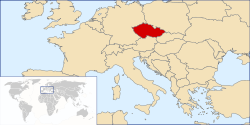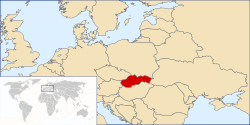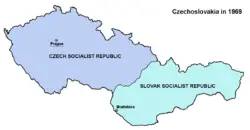Dissolution of Czechoslovakia
The dissolution of Czechoslovakia, which took effect on January 1, 1993, saw Czechoslovakia split into two separate countries: The Czech Republic and Slovakia. It is sometimes referred to as the "Velvet Divorce" in English and in some other languages, a reference to the non-violent "Velvet Revolution" of 1989 that led to the end of the rule of the Communist Party of Czechoslovakia and the formation of a new, non-Communist government. Both nation-states joined the European Union in 2004. Relations are cordial, a testimony to the amicable way in which dissolution was handled. While relations between the two communities had often been tense, under Austria-Hungary, Germans were blamed for dominating both communities while under the totalitarian communists everyone was oppressed unless they belonged to the party elite. From the start, Czechoslovakia had been an artificial creation. Neither province was given the chance to find national fulfillment within a Nation-state and many cherished the chance to do so. Slovakia was briefly independent between 1939 and 1945 but only as a client state of Nazi Germany. On the one hand, some people may regret the demise of a multi-cultural state that has split into two smaller, homogeneous units. On the other hand, within the wider framework of the European Union these units are allied not merely with each other but with many more nations. The EU is itself a multi-cultural construct.
Where strife exists, rightly of wrongly, on ethnic lines and national groups demand autonomy or self-governance, one possible solution is to allow the formation of smaller units which can then cooperate with others within the larger trans-national entity. Perhaps the peaceful and amicable separation of Slovakia from the Czech Republic and vice versa can serve as a model for other similar contexts where communities that became part of a larger nation-state under less than ideal circumstances and have unfulfilled national aspirations can achieve their goals. Of course, few nations willingly agree to allow provinces or regions to secede. One solution is for the creation of more local governance across the globe within the contexts of larger structures such as the EU, since it can be argued that as long as nation-states remain the main unit of political organization, justice and equality will elude the human race.
Background


Czechoslovakia was created with the dissolution of Austria-Hungary at the end of World War I.
Bohemia had long agitated for greater autonomy and had increasingly demanded independence. In 1917, a meeting took place in Pittsburgh, U.S. where the future Czechoslovak president Tomas Masaryk and other Czech and Slovak representatives signed the "Pittsburgh accord," which promised a common state consisting of two equal nations, Slovakia and Czechia. Soon after, the philosophy of Edvard BeneŇ° pushed for greater unity and a single nation. Up until World War II, it was a democratic republic. Tension existed between the dominant Czechs and the smaller German and Slovak communities. The Germans, under Austria-Hungary, had often been blamed for enjoying a privileged status. In 1938, the German speaking Sudetenland became part of Germany. In the spring of 1939, with the approval of Adolf Hitler and a majority of Slovaks, the Slovak Republic was created as a puppet-Nazi state. During the second world war, Germany invaded and occupied Czechoslovakia. After the war, it fell within the Soviet Union zone. Pre-war borders were restored (although not entirely, since some territory became part of what was then Soviet Ukrainea. The Soviets set up the Czechoslovak Socialist Republic, originally a centrally run, communist state.
In 1968, the Constitutional Law of Federation reinstated an official federal structure (of the 1917 type), but during the "Normalization period" in the 1970s, Gust√°v Hus√°k (although a Slovak himself) returned most control to Prague. This approach encouraged a regrowth of separation after the fall of communism. Also in 1968, a pro-democracy movement briefly took power (January 5 to August 21, 1968) and severed the link with the Soviets, only to fall when the Soviets sent troops into the capital, Prague.
Separation
By the 1990s, the Czech Republic's GDP per capita was some 20 percent higher than Slovakia's, but its long-run GDP growth was lower. Transfer payments from the Czech budget to Slovakia, which had been the rule in the past, were stopped in January 1991. As communism in East Europe began to collapse in East Europe and in the Soviet Union itself, what became known as the Velvet Revolution took place. Between November 16 and December 29, 1989, a series of non-violent protests against the Communist government broke out. In the face of public opinion, the government resigned. In June 1990, democratic elections were held. V√°clav Havel had been elected President at the end of December, one of the intellectual leaders of the anti-communist resistance.
Many Czechs and Slovaks desired the continued existence of a federal Czechoslovakia. A slight majority of Slovaks, however, advocated a looser form of co-existence or complete independence and sovereignty. In the next years, political parties reemerged, but Czech parties had little or no presence in Slovakia, and vice versa. In order to have a functional state, the government demanded continued control from Prague, while Slovaks continued to ask for decentralization.
V√°clav Klaus was first among the Czechs who supported separation as an alternative to the constant bickering that prevailed at the time. He approached Vladim√≠r Meńćiar and suggested, "Let us work together on Velvet separation."
In 1992, the Czech public elected V√°clav Klaus and others who demanded either an even tighter federation ("viable federation") or two independent states. Vladim√≠r Meńćiar and other leading Slovak politicians of the day wanted a kind of confederation. The two sides opened frequent and intense negotiations in June. On July 17, the Slovak parliament adopted the Declaration of independence of the Slovak nation. Six days later, politicians decided to dissolve Czechoslovakia at a meeting in Bratislava.
The goal of negotiations switched to achieving a peaceful division. On November 13, the Federal Assembly passed Constitution Act 541 which settled the division of property between the Czech lands and Slovakia. With Constitution Act 542, passed on November 25, they agreed to the dissolution of Czechoslovakia as of December 31, 1992.
The separation occurred without violence, and was, thus, said to be "velvet," much like the "Velvet revolution" which preceded it, which was accomplished through massive peaceful demonstrations and actions. In contrast, other post-communist break-ups (such as the Soviet Union and Yugoslavia) involved violent conflict.
Legal aspects
Division of national property
Most of federal assets were divided in the ratio 2 to 1 (the approximate ratio between the Czech and Slovak population within Czechoslovakia), including army equipment, rail and airliner infrastructure. Some minor disputes (for example, about gold reserves stored in Prague, federal know-how valuation) lasted for a few years after dissolution.
Currency division
Initially, the old Czechoslovak currency, the Czechoslovak koruna, was still used in both countries. Fears of economic loss on the Czech side caused the two states to adopt two national currencies as early as February 8, 1993. At the beginning, the currencies had an equal exchange rate, but later on, for most of the time, the value of the Slovak koruna was lower than that of the Czech koruna (up to c. 30 percent, in 2004, around 25‚Äď27 percent, as of 2008, about 20 percent).
Flag and the coat of arms
The agreement on the dissolution of Czechoslovakia stipulated that former symbols of the federation would not be used by member states. This provision has not been observed by the Czech Republic who continued to use the Flag of Czechoslovakia as its national flag. Slovakia objected to this without success, though prominent Slovak vexillologists accepted the retention of the flag by the Czechs, citing the failure of their search for a new flag.
Consequences
Economy
The dissolution had some negative impact on the two economies, especially in 1993, as traditional links needed to accommodate the bureaucracy of international trade were severed, but the impact was considerably lower than expected by many people.
The hopes that dissolution would quickly start an era of high economic growth in the Czech Republic (without the need to "sponsor the less developed Slovakia") proved plainly wrong or highly exaggerated. Also, the hope of a stand-alone, unexploited Slovakia becoming a new "economic tiger" was partially unfounded. The Slovak GDP level is still lower than that of the Czech Republic; the growth of the Slovak GDP, however, has been consistently higher than the Czech one since 1994.
Citizenship
Dual citizenship between the two states was originally not allowed; only years later did courts make it possible. Only a handful of people have exercised this correctly. Since both countries are EU members, this issue has become less important due to the EU Freedom of Movement for Workers policy. That policy means that EU citizens have the right to live and work anywhere within the EU (subject to some exceptions during a transitional period). In the case of movement between the Czech Republic and Slovakia, this policy took effect from 2004.
People of both countries were allowed to cross the border without a passport and were allowed to work anywhere without the need to obtain an official permit. Border checks were completely removed on December 21, 2007, when both countries joined the Schengen Agreement.
Roma
One of the problems not solved during dissolution was the question of a large number of Roma living in the Czech Republic, who were born and officially registered in today's Slovakia. Most of them did not re-register their official place of stay during the months before dissolution, and so the question of their citizenship was left open. The 1992 Czech Nationality Act allowed a grant of automatic citizenship only to those born in the Czech lands. For others, the right to citizenship required proof of a five-year period of residence, an "unobjectionable" criminal record, significant fees, and a complicated bureaucratic process; this reportedly excluded a rather large percentage of Roma.[1] The Slovak government did not want to grant citizenship to non-residents. Significant numbers of Roma living in Czech orphanages did not have their legal status clarified, and were released from care as adults, but non-citizens without any right to work or live in the Czech Republic.[2]
Under pressure from the European Union, the Czech government made amendments to its nationality law in 1999 and 2003, which effectively solved the problem; compensation, however, has not been provided to those rendered stateless in 1992.[1]
Language contacts
In the former Czechoslovakia, the first television channel was a federal one and the Czech and Slovak language was used in equal ratios in the TV news there, although foreign films and TV series were almost exclusively dubbed into Czech, for example. This made almost all people of both nations passively bilingual, that is, they were able to understand but not necessarily speak the other language. After the divorce the new TV channels in the Czech Republic practically stopped using Slovak, and young Czech people now have a much lower understanding of the Slovak language. The Czech TV news, however, recently started to reintroduce Slovak-language coverage from Slovakia. Also, the number of Slovak-language books and newspapers sold in the Czech Republic dropped drastically. In Slovakia, however, most cable TV providers offer Czech TV channels, and for economic reasons, many TV programs on Slovak TV channels are still dubbed into Czech, some films in cinemas are subtitled in Czech and there are far more Czech-language books and periodicals on the market than before the divorce. Young Slovak people still have the same knowledge (if not better) of the Czech language as their predecessors.
Sport
At the FIS Nordic World Ski Championships 1993 in Falun, Sweden, the ski jumping team competed as a combined Czech Republic-Slovakia team in the team large hill event, winning a silver. The team had been selected prior to the dissolution. Jaroslav Sakala won two medals in the individual hill events for the Czech Republic at those games along with his silver in the team event.
The official break-up occurred right in the middle of the 1993 World Junior Hockey Championship, which also took place in Sweden. The team representing Czechoslovakia was called "Czech-Slovak" starting on January 1.
For the qualifying session for the 1994 FIFA World Cup, the national soccer team competed under the name RCS which stood for "Representation of Czechs and Slovaks." It was after this that the teams were then officially split up into Czech Republic national football team and Slovakia national football team.
Legacy
After a transition period of roughly four years, during which the relations between the states could be characterized as a "post-divorce trauma," the present relations between Czechs and Slovaks, as many people point out, are probably better than they have ever been.
No movement to re-unite Czechoslovakia has appeared and no political party advocates it in its program. Political influences between the countries are minimal. Trade relationships were re-established and stabilized. After a short interruption, Slovakia's mountains are again the target of a growing number of Czech tourists.
Slovakia and the Czech Republic both became a member of the European Union in 2004. While deciding not to remain within one state they cooperate with other member states of the Union within a larger, multi-national framework. Czechoslovakia had always been an artificial creation. Under communist rule, tension between the two communities was ignored. Separation into two distinct nation states each with their distinctive cultural and linguistic identities has in this case left neither side bitter. Under Austria-Hungary, it was Germans who were accused of dominating both communities. Under communism, everyone was equally oppressed by a totalitarian system. Nationalism was suppressed in favor of communist ideology and internationalism. Uniformity, not diversity, was the official stance. Now part of the wider European space, the two communities can relate to each other across open borders amicably and without rancor.
Notes
- ‚ÜĎ 1.0 1.1 Jasminka Dedińá, Roma and Stateless, Brussells: European Parliament Committee on Civil Liberties, Justice and Home Affairs.
- ‚ÜĎ Ira Zoon, The manufactured troubles of L'udovit Gorej, Roma Rights Quarterly. Retrieved August 23, 2008.
ReferencesISBN links support NWE through referral fees
- Dńõdek, OldŇôich. The Break-up of Czechoslovakia: An In-Depth Economic Analysis. Aldershot, UK: Avebury, 1996. ISBN 978-1859722763
- Economist Intelligence Unit. Czechoslovakia in Transition. London: Economist Intelligence Unit, 1990. ISBN 978-0850583922
- Innes, Abby. Czechoslovakia: The Short Goodbye. New Haven, CT: Yale University Press, 2001. ISBN 978-0300090635
- Musil, JiŇô√≠. The End of Czechoslovakia. Budapest, HU: Central European University Press, 1995. ISBN 978-1858660202
- Wheaton, Bernard, and Zdenek Kavan. The Velvet Revolution: Czechoslovakia, 1988-1991. Boulder, CO: Westview Press, 1992. ISBN 978-0813312033
Credits
New World Encyclopedia writers and editors rewrote and completed the Wikipedia article in accordance with New World Encyclopedia standards. This article abides by terms of the Creative Commons CC-by-sa 3.0 License (CC-by-sa), which may be used and disseminated with proper attribution. Credit is due under the terms of this license that can reference both the New World Encyclopedia contributors and the selfless volunteer contributors of the Wikimedia Foundation. To cite this article click here for a list of acceptable citing formats.The history of earlier contributions by wikipedians is accessible to researchers here:
The history of this article since it was imported to New World Encyclopedia:
Note: Some restrictions may apply to use of individual images which are separately licensed.
